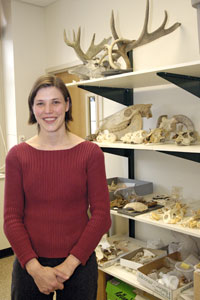Researcher Studies Bones For Clues
To Origin Of Agriculture
 |
|
Natalie Munro, an assistant
professor of anthropology who specializes in zooarchaeology,
with animal bones in her lab at Beach Hall.
|
|
Photo by Dollie Harvey |
Whether sifting through the sand near the Sea of Galilee or examining the surface of a bone remnant in her lab, Natalie Munro has one goal: to understand the origins of agriculture.
“Why did people stop hunting and gathering around 10,000 years ago and suddenly decide to settle down in agricultural communities?” asks Munro, an assistant professor of anthropology. “It’s a very dramatic change that had tremendous impact on human adaptations in general, and also the future of social change. The rise of civilization was dependent on it.”
There is much debate about the roots of agriculture, says Munro, a zooarchaeologist who studies what she calls “trash” – mostly bones from animals that prehistoric humans hunted.
Her research focuses on the origins of agricultural societies in the Near East, especially the Fertile Crescent region extending from Israel and Jordan north through Lebanon, south central Turkey, and into the Zagros mountains of Iran and Iraq.
She is interested in what occurred just before agriculture began. “What were the seeds that encouraged it to happen? What were the conditions that existed right before, that might have pushed it along?” she asks.
Munro studies skeletal remains dating to between about 15,000 to 9,000 years ago, to understand human impacts on wild animal populations and their implications for the beginning of animal domestication, human demography, and economic change.
“People were eating tortoises for hundreds and thousands of years,” she says. “They were extremely easy to capture. But suddenly, in the periods before agriculture began, faster animals like hares and partridges appeared, animals that you can’t skip out and grab for your dinner. More time and energy had to be invested to get them, and they didn’t provide much food.”
That means there was pressure to find food, says Munro, who conducts much of her work in northern Israel in the southern Levant. “When we find remains of hares and partridges, it indicates an increase in human population size, and tells us that people are settling in one place, which happens with agriculture. If you’re in one place for a longer time, you start to deplete the resources and are forced to hunt less desirable prey.”
Munro, who spends several months in Israel every summer, says she digs in excavation sites, but spends much of her time in the lab analyzing bones.
“I identify what piece of the skeleton it is – a femur, scapula, a tooth,” she says. “I look at patterns of breakage, how are they broken, and into how many fragments. I look under the microscope at the surfaces of the fragments to see if there is other kinds of damage, like cut marks from human tools or impact marks where a tool might have hit the bone to smash it open.”
When there is more pressure to obtain food, Munro says, “people bash up skeletons to get all the nutrients that they can possibly get, like the grease and marrow from the bones. They’re squeezing every last drop out of the animal.”
Munro, who joined the UConn faculty in 2002, earned her doctorate in anthropology at the University of Arizona, Tucson.
She is also conducting research on gazelles. “They were never domesticated, but were subjected to the same kinds of pressures by human hunting as animals like sheep and goat which were domesticated in neighboring regions,” she says.
The goal of the gazelle project is “to create a very robust picture of the whole process of change in human use of these animals leading up to domestication of sheep and goats. We can use gazelles as a way of understanding the earliest stages of domestication, which must have grown out of the phase of intensive hunting that happened in the periods right before agriculture.”

